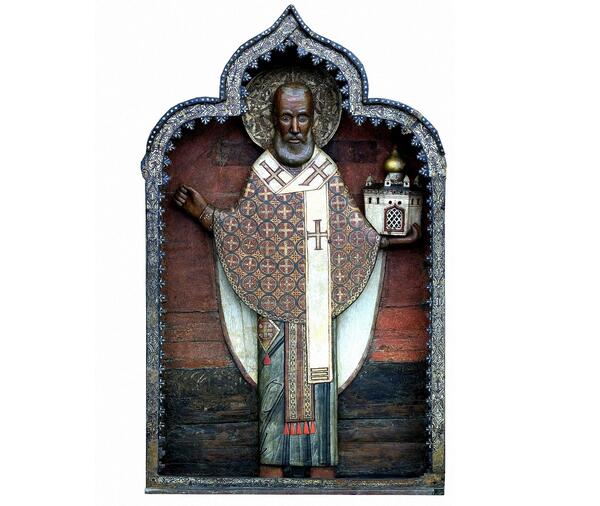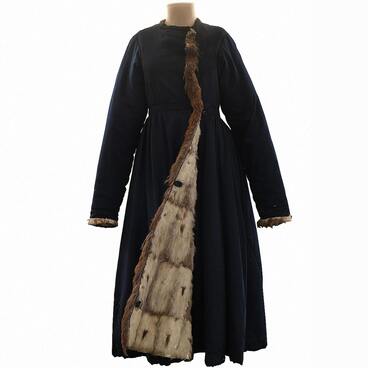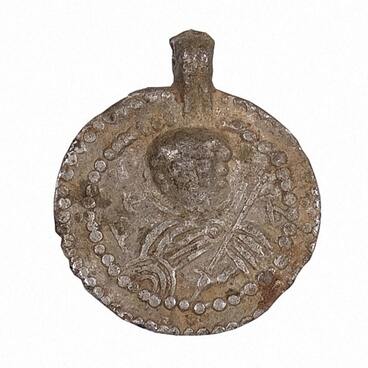St. Nicholas is one of the most venerated saints in the Orthodox world. He is considered the patron saint of travelers and sailors, and a speedy helper to all who call upon him in misfortune.
The image of St. Nicholas “with a sword and a church” is especially revered by Christians. In Russia, the first image of this type was created in the town of Mozhaisk near Moscow, where a figure of the saint with his hands spread and raised in prayer was made in the 14th century. The sword symbolized defending the faith and urging citizens to fight for their homeland and its religion. The church in the saint’s left hand referred to the development and strengthening of the Orthodox Church.
The figure of St. Nicholas of Mozhaisk from the collection of the Kargopol Museum also used to hold a sword in the right hand, but this part of the sculpture has been lost. The church in the left hand has been preserved.
The figure was carved out of a spruce block by an unknown master. The hands of the saint, the sleeves of the phelonion (the special vestment), the shoes, as well as the church were made separately. The saint’s face was portrayed according to the canons but still had some specific features — a wide nose, almond-shaped eyes, thick eyebrows, and a well-defined lower lip.
The Old Russian traditions of sculpture were very different from classical art. Russian sculptors did not try to depict the exact anatomy or volumes of a figure. Sculpture gravitated towards iconography, with delicate body proportions, approximate volumes, and a flat back part of a statue.
The first statue of St. Nicholas in an icon case, which was kept in Mozhaisk, is considered to be the oldest Russian statue of this type. Researchers believe that it was commissioned by Cyprian, the Metropolitan of Moscow. It was inspired by the silver image of St. Nicholas from the Italian city of Bari, where his relics are kept. The Mozhaisk statue was believed to possess miraculous powers and was revered by both common people and Russian princes. Numerous copies were made from this statue, with similar statutes found throughout the country.
In Kargopol, there were several statues of St. Nicholas. The most highly revered one was the image from the Holy Spirit Parish, created in the first half of the 17th century. It survived the decree of Peter the Great of 1722 which prohibited the use of sculptures in churches. However, later it suffered from the decree of 1767 which stated that “artists should not create improper images”, and that “strange and ridiculous images” should be “eradicated by any means.” Many bishops considered carved icons to be a relic of paganism or Catholicism and started getting rid of such statues.
Thus, Bishop Viktor of Olonets and Kargopol, who came to Kargopol in the early 1780s, ordered “to take all the decorations from the statue and bring the statue out of the church.” Churchwarden Zagorodsky-Bolshoy made great efforts to bring the statue of St. Nicholas back: he corresponded with the church authorities for many years, and finally achieved his goal by the end of the 18th century. Metropolitan Gavriil of Novgorod and St. Petersburg allowed the statue to be returned.
The image of St. Nicholas “with a sword and a church” is especially revered by Christians. In Russia, the first image of this type was created in the town of Mozhaisk near Moscow, where a figure of the saint with his hands spread and raised in prayer was made in the 14th century. The sword symbolized defending the faith and urging citizens to fight for their homeland and its religion. The church in the saint’s left hand referred to the development and strengthening of the Orthodox Church.
The figure of St. Nicholas of Mozhaisk from the collection of the Kargopol Museum also used to hold a sword in the right hand, but this part of the sculpture has been lost. The church in the left hand has been preserved.
The figure was carved out of a spruce block by an unknown master. The hands of the saint, the sleeves of the phelonion (the special vestment), the shoes, as well as the church were made separately. The saint’s face was portrayed according to the canons but still had some specific features — a wide nose, almond-shaped eyes, thick eyebrows, and a well-defined lower lip.
The Old Russian traditions of sculpture were very different from classical art. Russian sculptors did not try to depict the exact anatomy or volumes of a figure. Sculpture gravitated towards iconography, with delicate body proportions, approximate volumes, and a flat back part of a statue.
The first statue of St. Nicholas in an icon case, which was kept in Mozhaisk, is considered to be the oldest Russian statue of this type. Researchers believe that it was commissioned by Cyprian, the Metropolitan of Moscow. It was inspired by the silver image of St. Nicholas from the Italian city of Bari, where his relics are kept. The Mozhaisk statue was believed to possess miraculous powers and was revered by both common people and Russian princes. Numerous copies were made from this statue, with similar statutes found throughout the country.
In Kargopol, there were several statues of St. Nicholas. The most highly revered one was the image from the Holy Spirit Parish, created in the first half of the 17th century. It survived the decree of Peter the Great of 1722 which prohibited the use of sculptures in churches. However, later it suffered from the decree of 1767 which stated that “artists should not create improper images”, and that “strange and ridiculous images” should be “eradicated by any means.” Many bishops considered carved icons to be a relic of paganism or Catholicism and started getting rid of such statues.
Thus, Bishop Viktor of Olonets and Kargopol, who came to Kargopol in the early 1780s, ordered “to take all the decorations from the statue and bring the statue out of the church.” Churchwarden Zagorodsky-Bolshoy made great efforts to bring the statue of St. Nicholas back: he corresponded with the church authorities for many years, and finally achieved his goal by the end of the 18th century. Metropolitan Gavriil of Novgorod and St. Petersburg allowed the statue to be returned.



